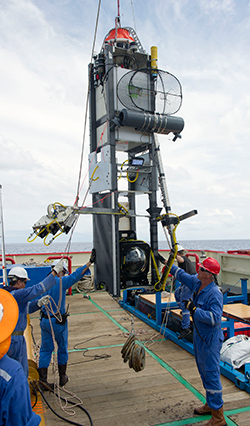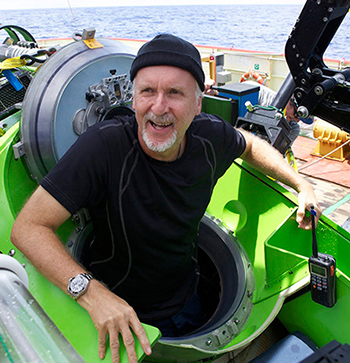
By:
- Rob Monroe
Published Date
By:
- Rob Monroe
Share This:
James Cameron Helps Support Undersea Exploration at Scripps with Donation of ‘Lander’
Renowned filmmaker to give campus presentation as recipient of 2013 Nierenberg Prize for Science in the Public
The Scripps Institution of Oceanography ocean exploration arsenal will grow in a big way May 31 when “Titanic” and “Avatar” director James Cameron gifts a piece of history to the institution.

Deep-sea lander. Photo by Charlie Arneson.
The ocean frontier explorer and world-renowned filmmaker, who has been named by Scripps as the recipient of the 2013 Nierenberg Prize for Science in the Public, will deliver a presentation at UC San Diego on his record-setting DEEPSEA CHALLENGE expedition and exploration of the frontiers of the deep sea. Cameron will formally donate an extreme-depth unmanned undersea exploration system known as a “lander” developed by a Scripps researcher for the expedition. Cameron last year became the first person to complete a solo dive to the world’s deepest point.
The Nierenberg Prize for Science in the Public Interest, awarded annually by Scripps, is named for William A. Nierenberg (1919-2000), a renowned national science leader who served Scripps Oceanography as director from 1965 to 1986. In addition to the lander gift to Scripps, Cameron will donate the $25,000 Nierenberg Prize money to Scripps to kickstart operations of a new “Lander Lab” based at Scripps to oversee the lander system’s operations and research applications.
Developed by longtime Scripps engineer Kevin Hardy for Cameron’s historic DEEPSEA CHALLENGE expedition, the lander includes an instrument frame, command/control spheres, empty camera spheres, buoyancy spheres, water and biological sampling systems, and deck support gear. The Cameron lander comes equipped as a complete deep-exploration system that can be configured in a full 14-foot, 1,000-pound mode—the workhorse design for Cameron’s historic DEEPSEA CHALLENGE expedition—or smaller versions that can be deployed from a variety of vessels.
“James Cameron’s landers worked in conjunction with his record-setting manned submarine by providing a stand-alone camera platform to film the submarine, to survey and scout locations prior to manned dives, and to test new technology before integration on the manned submarine,” said Hardy. “The lander also acted as a baited lure to attract fish and other animals, concentrating them for photography and behavioral studies.”

James Cameron emerges from the DEEPSEA CHALLENGER. Photo by Mark Thiessen/National Geographic.
Sampling devices can be tailored to the lander to address various branches of ocean science, including biology, chemistry, geology, and physics.
“Scripps Institution of Oceanography is extremely grateful to James Cameron for his generous lander gift, which not only holds historical value, but will prove to be a key resource for many significant deep-sea expeditions in the near future,” said Catherine Constable, interim director of Scripps. “The lander will help us unlock the mysteries of Earth’s least explored environment, which remains a true frontier of science.”
Doug Bartlett, a Scripps marine microbiologist and chief scientist of Cameron’s DEEPSEA CHALLENGE expedition, plans to put the lander system to work soon for Scripps science.
“The lander will be used with various payloads to collect seawater, sediments, animals in baited traps, and microbes following in-situ filtration and in-situ enrichment,” said Bartlett. “It may see operation in the (Pacific Ocean’s) Sirena Deep this June.”
On March 26, 2012, Cameron plunged 11 kilometers (6.8 miles) below the ocean surface in a one-man submarine to the Challenger Deep in the Pacific Ocean’s Mariana Trench, the first solo diver to reach such depths. Scripps has been collaborating with Cameron for nearly a decade, focusing on developing new ways to explore and study the deepest parts of the oceans. The DEEPSEA CHALLENGE was a joint scientific expedition by Cameron, a National Geographic explorer-in-residence; National Geographic; and Rolex to conduct deep-ocean research and exploration.
Although the Cameron presentation event is sold out, more information is available at: nierenberg.eventbrite.com.
Share This:
You May Also Like
Stay in the Know
Keep up with all the latest from UC San Diego. Subscribe to the newsletter today.


